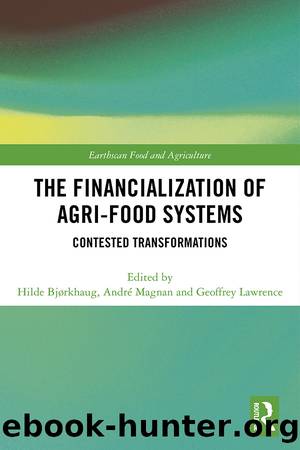The Financialization of Agri-Food Systems by unknow

Author:unknow
Language: eng
Format: epub
Tags: Nonfiction, Social & Cultural Studies, Social Science, Sociology, Rural
ISBN: 9781351654920
Publisher: Taylor and Francis
Published: 2018-10-09T04:00:00+00:00
Figure 8.2 Foods that supplied fats to the Japanese 1960â2013.
Source: MAFF food balance data.
Sogo-shosha regained their strength as the Japanese economy and society recovered, and international trade grew. In addition to that, sogo-shosha increased their significance in Japanâs food sector by controlling feed-tolivestock and from ingredients to food processing industries, as well as through the âfood kombinatâ project in the 1960s and via incoming foreign investment into fast foods in the 1970s.
The Korean War of 1950â3 and the Cold War led to changes in occupation policy in Japan, allowing the once-dismantled sogo-shosha to reassemble. Mitsubishi Corporation incorporated again in 1954, and Mitsui & Co. in 1959. Trade was gradually liberalized, and sogo-shosha resumed as the major players of trade and investment as well as the organizers of business and industry development. Sogo-shosha and other Japanese companies re-formed more loose financial and business groups around the major banks instead of officially connected zaibatsu or holding companies. Sogo-shosha also became influential actors as Japanâs livestock industries developed rapidly in the 1960s based on imported grains, mainly soybean and corn (maize) from the US. Not only operating as the traders to import these grains, sogo-shosha also invested in the feed industries, as well as broiler and other livestock operations, and contributed to structuring livestock integration in Japan and increased the supply of animal products (milk, eggs, and meat) in the Japanese market (Integration Research Group, 1971).
On the procurement side of the integration, sogo-shosha collaborated with the stateâs national planning to develop the âfood kombinatâ. Since the 1960s the Japanese government promoted the âfood kombinatâ6 project in order to modernize Japanâs food industries. New technologies, new forms of capital investment, and changes in the workplace were introduced in an attempt to make Japanese firms competitive against foreign large-scale food companies. On the distribution side of this grand project of integration, sogo-shosha supported foreign fast-food chains entering the Japanese market. Foreign direct investment in Japanâs restaurant sector was gradually deregulated and â by the beginning of the 1970s â there was a rush of American-based fast-food into Japan (Kentucky Fried Chicken arrived in 1970, McDonalds in 1971, Mister Donut and Dunkinâ Donuts in 1971, and Dairy Queen in 1972) (Kozuka, 1999). Often the sogo-shosha worked as the partner of American fast-food in Japan. In this way, sogoshosha structured the feed-to-livestock integration both as direct participants and as providers of financial capital: from the import of grains, processing the grain at the food kombinat on the port, supplying feed and operating livestock, as well as processing meat and proliferating fast-food restaurants.
Other food companies developed as well in post-World War II Japan. As the supply increased for basic ingredients like wheat, vegetable oil, and sugar based on imported grains, the Japanese food industry also began to sell processed foods using these ingredients. Oil-containing products like salad dressings came into the market at the end of the 1950s, meat sauce for pasta in 1959, and ready-made curry roux in 1960. Other products proliferating at this time were: margarine, ice cream, mayonnaise and other processed foods.
Download
This site does not store any files on its server. We only index and link to content provided by other sites. Please contact the content providers to delete copyright contents if any and email us, we'll remove relevant links or contents immediately.
How to Be a Bawse: A Guide to Conquering Life by Lilly Singh(6693)
Deep Work by Cal Newport(5471)
The Longevity Diet by Valter Longo(4446)
The Fat Loss Plan by Joe Wicks(4239)
The Four-Pack Revolution by Chael Sonnen & Ryan Parsons(3485)
The Ultimate Bodybuilding Cookbook by Kendall Lou Schmidt(3320)
The French Women Don't Get Fat Cookbook by Mireille Guiliano(2984)
Super Food Family Classics by Jamie Oliver(2912)
Turn Up Your Fat Burn! by Alyssa Shaffer(2812)
Factfulness_Ten Reasons We're Wrong About the World_and Why Things Are Better Than You Think by Hans Rosling(2754)
Not a Diet Book by James Smith(2726)
Tom Kerridge's Dopamine Diet: My low-carb, stay-happy way to lose weight by Kerridge Tom(2677)
Body Love by Kelly LeVeque(2630)
Self-Esteem by Matthew McKay & Patrick Fanning(2604)
The Unbecoming of Mara Dyer by Michelle Hodkin(2483)
Tone Your Tummy Type by Denise Austin(2368)
The Fat Chance Cookbook by Robert H. Lustig(2321)
LL Cool J's Platinum 360 Diet and Lifestyle by LL Cool J(2313)
Men's Health Best by Men's Health Magazine(2093)
